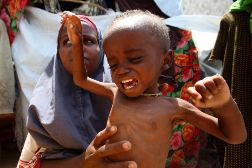 Famine spread to three new regions of Somalia, including the capital Mogadishu, as a US senator warned the catastrophe could be worse than the Ethiopian famine that claimed nearly 1 million lives in the 1980s.
Famine spread to three new regions of Somalia, including the capital Mogadishu, as a US senator warned the catastrophe could be worse than the Ethiopian famine that claimed nearly 1 million lives in the 1980s.
The new famine areas designated by the UN include two sites where hundreds of thousands of Somalis have fled in search of food.
“Famine is now present,” said Grainne Moloney, head of the UN Food Security and Nutrition Analysis Unit for Somalia (FSNAU).
“The three areas are the Afgoye corridor IDP [internally displaced persons] settlement, the Mogadishu IDP community, in all seven districts of the city, and in the Balaad and Adale districts of Middle Shabelle.”
Last month, the UN declared famine in the southern Bakool and Lower Shabelle regions of southern Somalia due to the prolonged drought in the Horn of Africa region.
Up to 409,000 Somalis are reported to be in the Afgoye corridor area, the world’s largest displacement camp, Ms Moloney said.
In the war-torn capital Mogadishu, up to 100,000 Somalis have fled from the drought, with up to 1,000 people arriving at the camp every day, according to the UN refugee agency.
“Despite increased attention in recent weeks, the current humanitarian response remains inadequate, due in part to ongoing access restrictions and difficulties in scaling-up emergency assistance programs, as well as funding gaps,” the UN unit said in a statement.
“As a result, famine is expected to spread across all regions of the south in the coming four to six weeks.”
At a US Senate hearing on the famine, Democratic Senator Chris Coons of Delware said: “It is the most severe humanitarian crisis in a generation, affecting food security for more than 12 million people across Somalia, Ethiopia, Kenya, Djibouti and surrounding areas.”
He called the famine “a children’s crisis,” noting that hundreds of thousands of children were “on the verge of death” in the Horn of Africa due to malnutrition.
Only half of the $US2 billion the United Nations has said is needed to provide emergency assistance had been committed, he said. The United States, the largest single donor, had pledged $US450 million.
“The international community must join the United States and many others in providing this critical aid in the near term in order to save lives, especially those of malnourished children and others in desperate need,” Mr Coons added.
The UN statement said recent torrential rains around the capital had added to the misery of those with basic shelter and already weakened by hunger.
“The current situation represents the most severe humanitarian crisis in the world today and Africa’s worst food security crisis since Somalia’s 1991-92 famine,” the UN added.
Famine implies at least 20 per cent of households face extreme food shortages, acute malnutrition in more 30 per cent of people, and two deaths per 10,000 people every day, according to UN definition.
Most of the areas declared to be in famine are controlled by Al-Qaeda-linked Al Shabaab rebels, who have blocked several key aid agencies from delivering aid.
Despite listing Al Shabaab as a terrorist group, the United States said on Tuesday it would support relief work in areas they controlled.
But the UN has said tens of thousands of people have already died.
US officials said they were maintaining sanctions against the militia, but would fund reputable groups that took the risks to get food into Shabaab-run territory.
The UN’s FSNAU said the price of staple cereals had more than doubled since 2010 in some areas of southern Somalia, normally the breadbasket of the war-wracked Horn of African country.
Deaths among the entire population had exceeded the famine threshold of two per 10,000 people daily in the Balaad and Adale regions, while deaths of children under five had reached 13 per 10,000 people every day among people fleeing the famine area.


